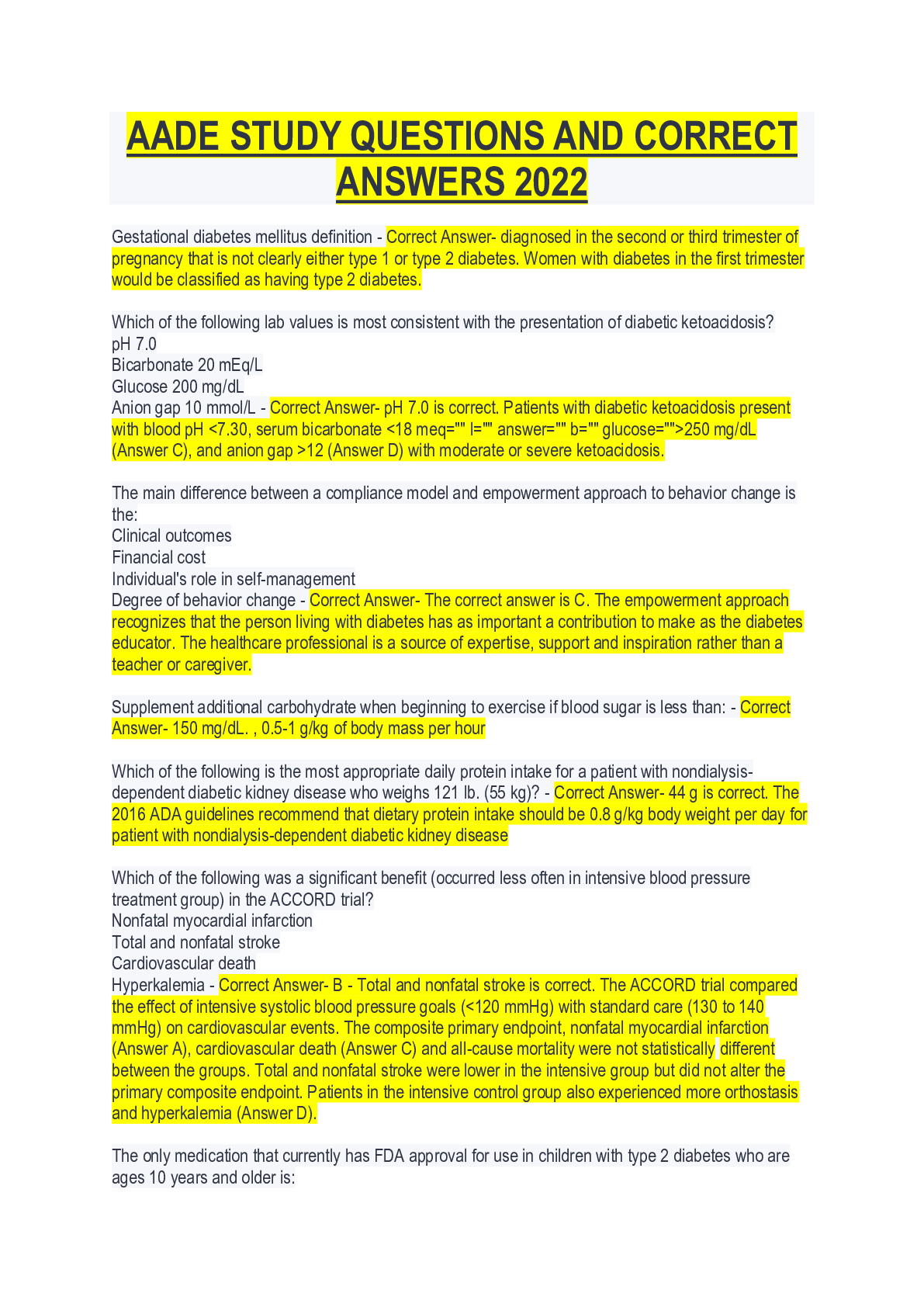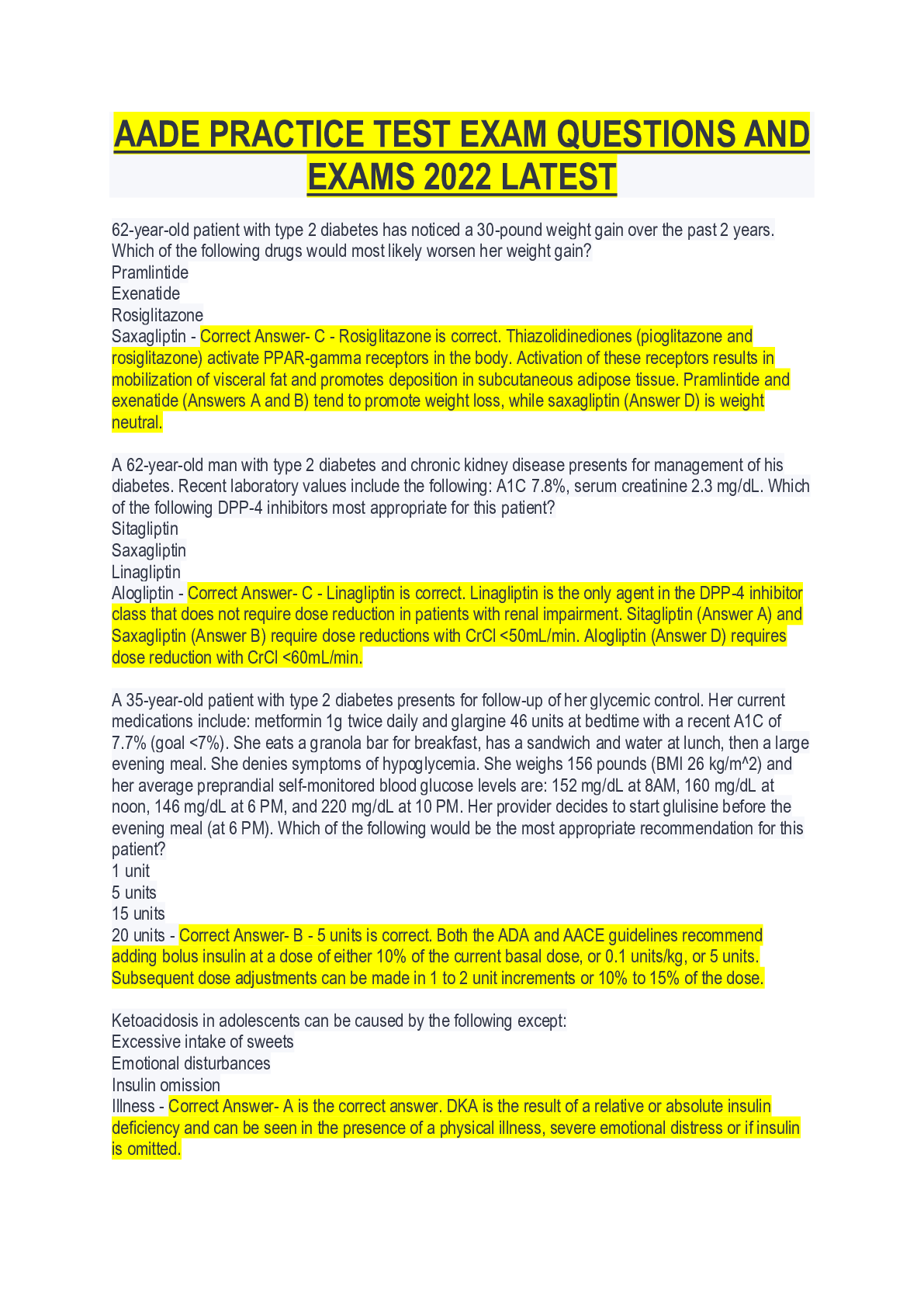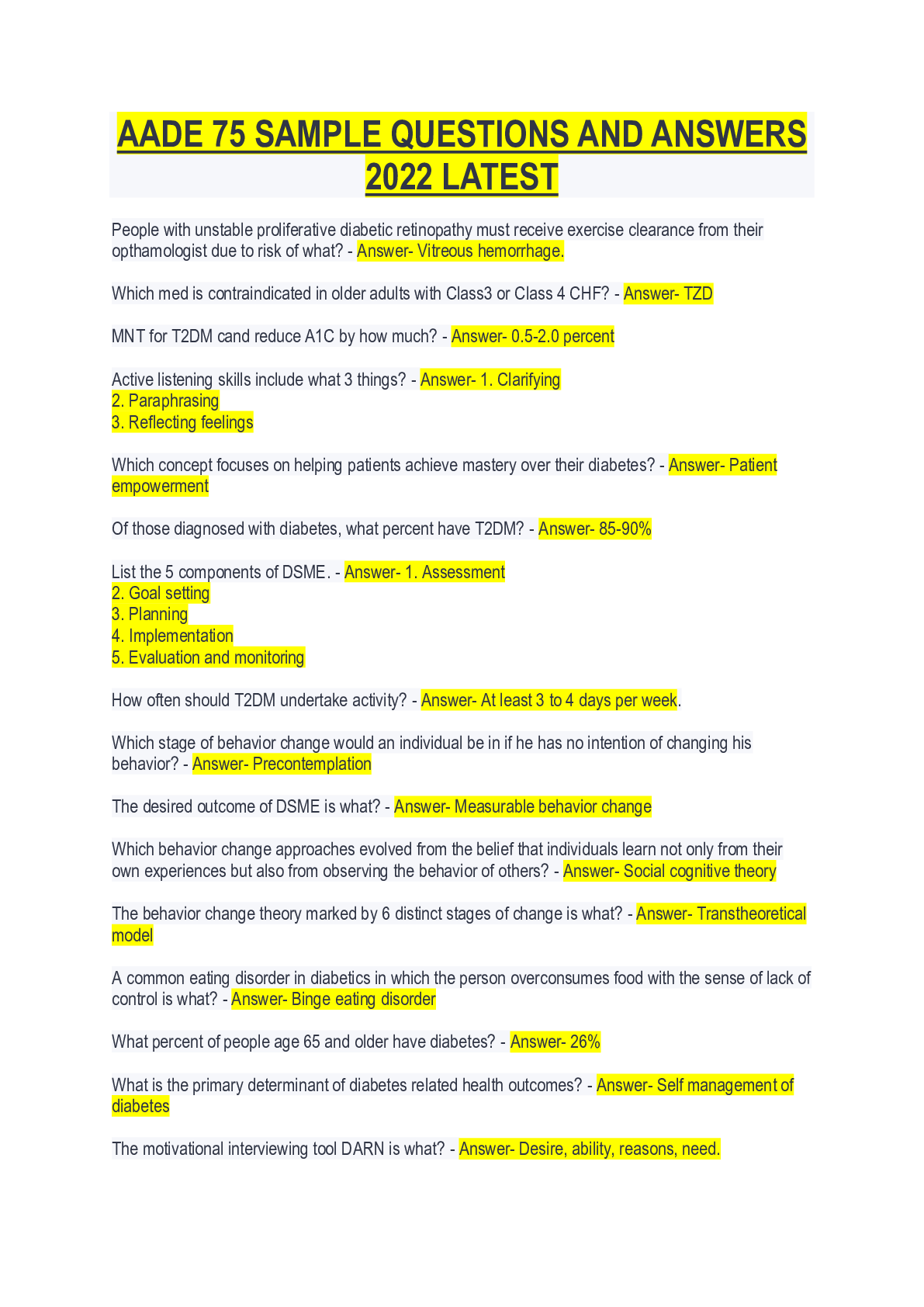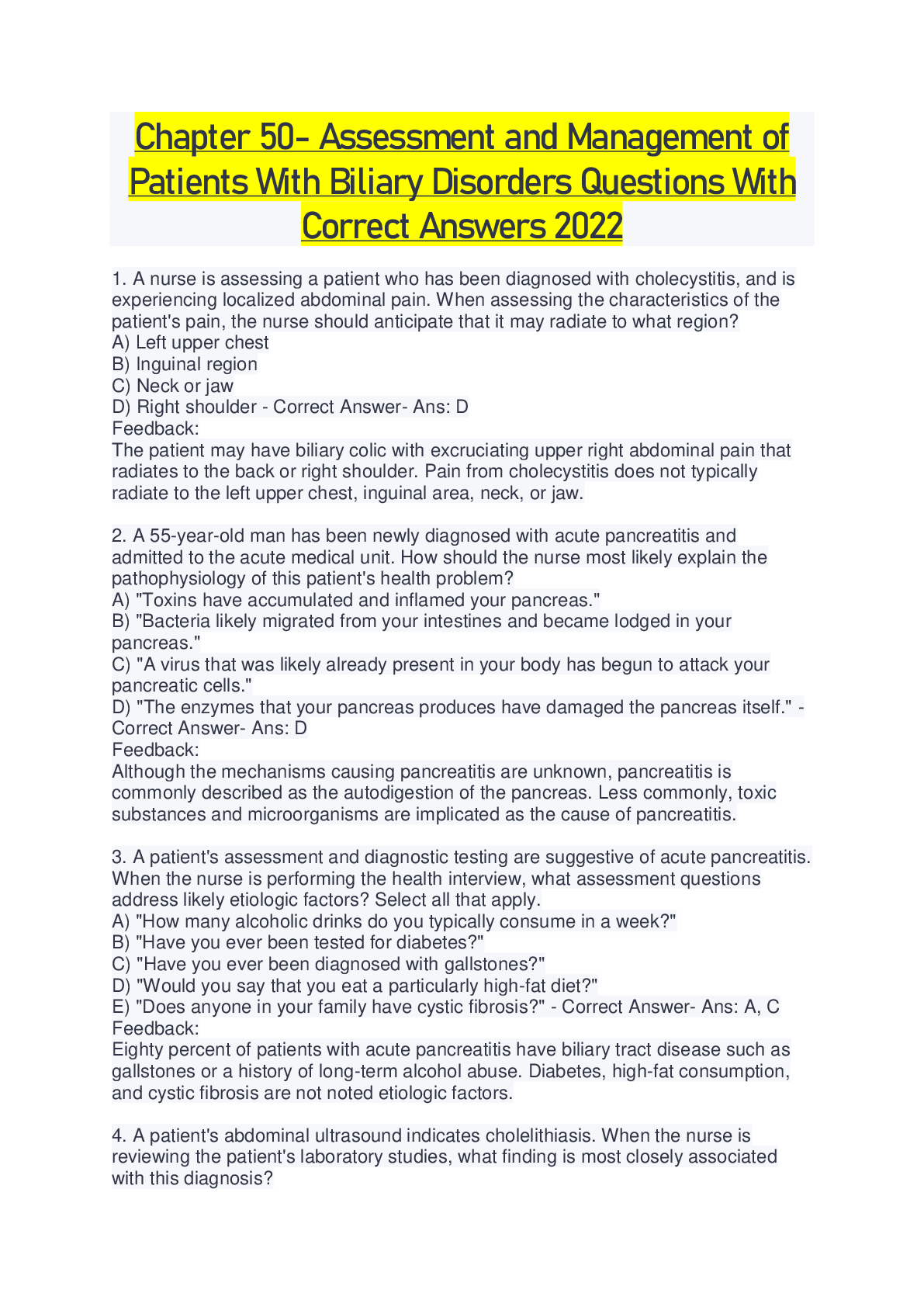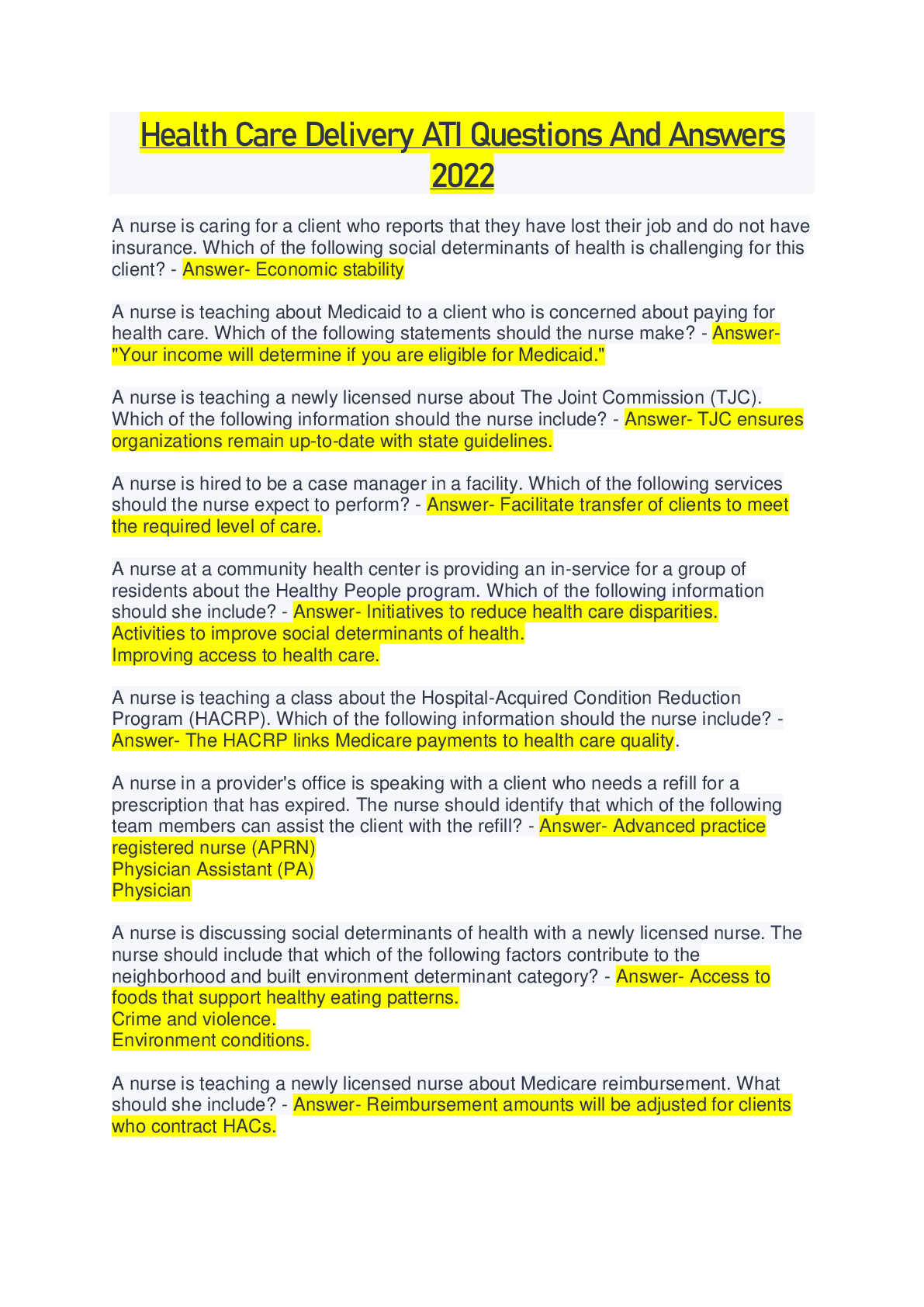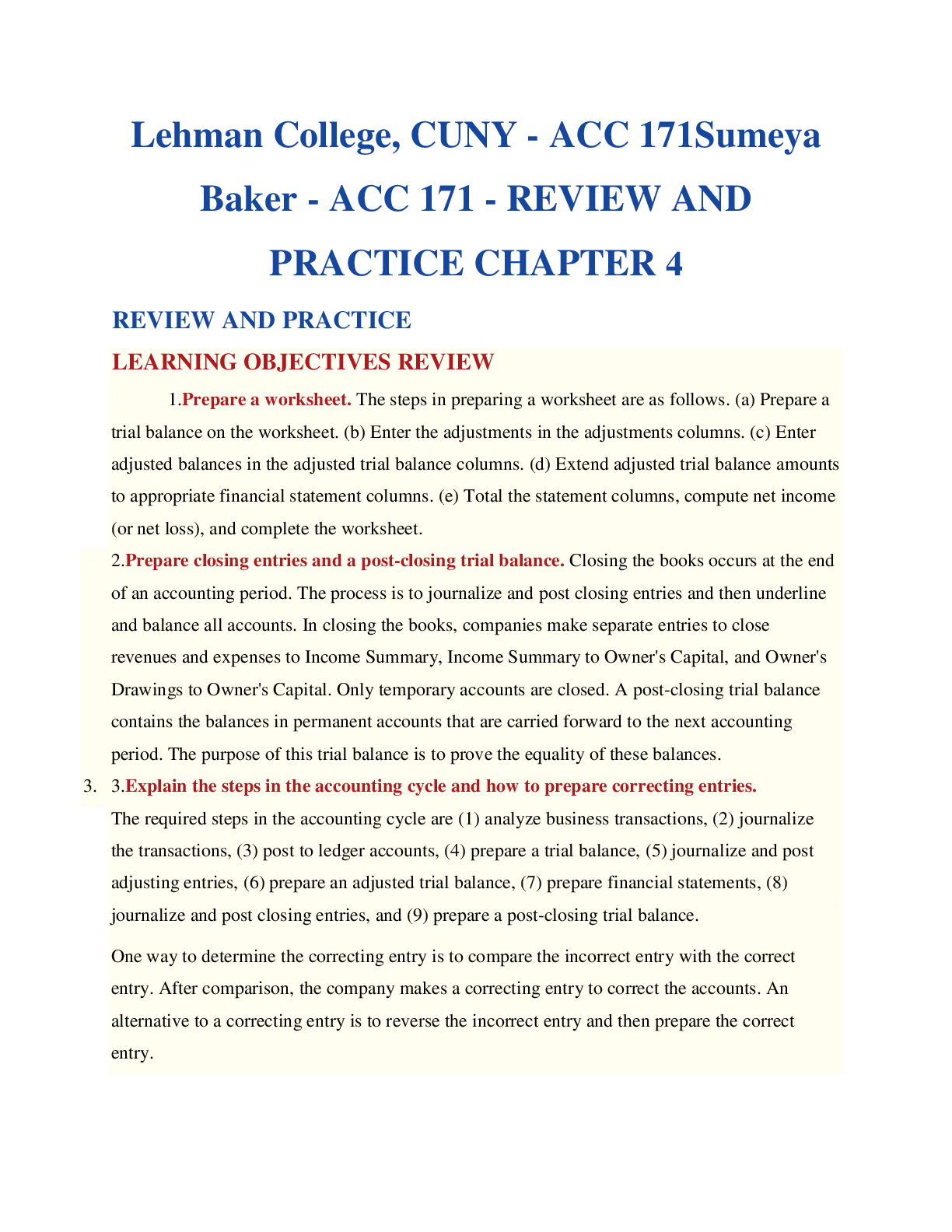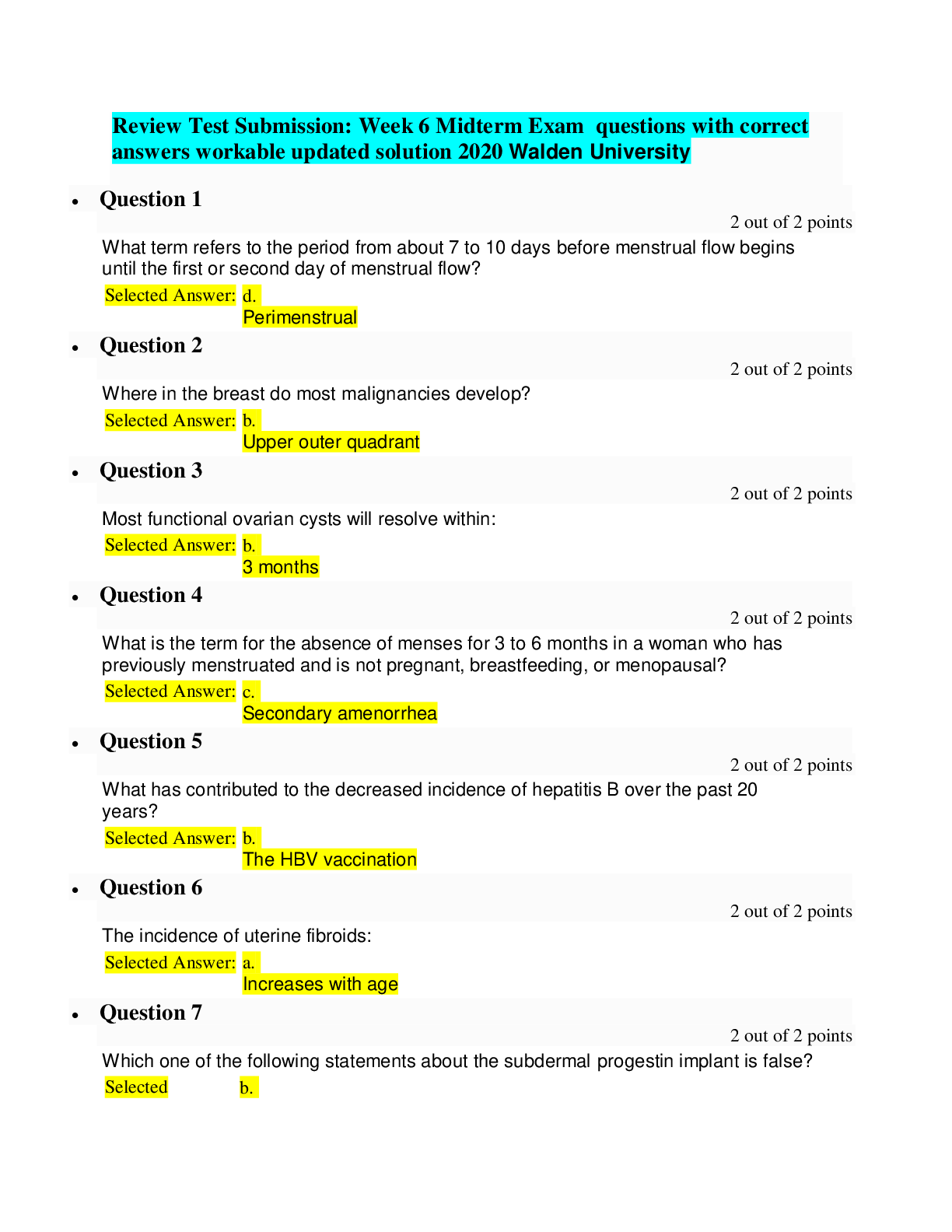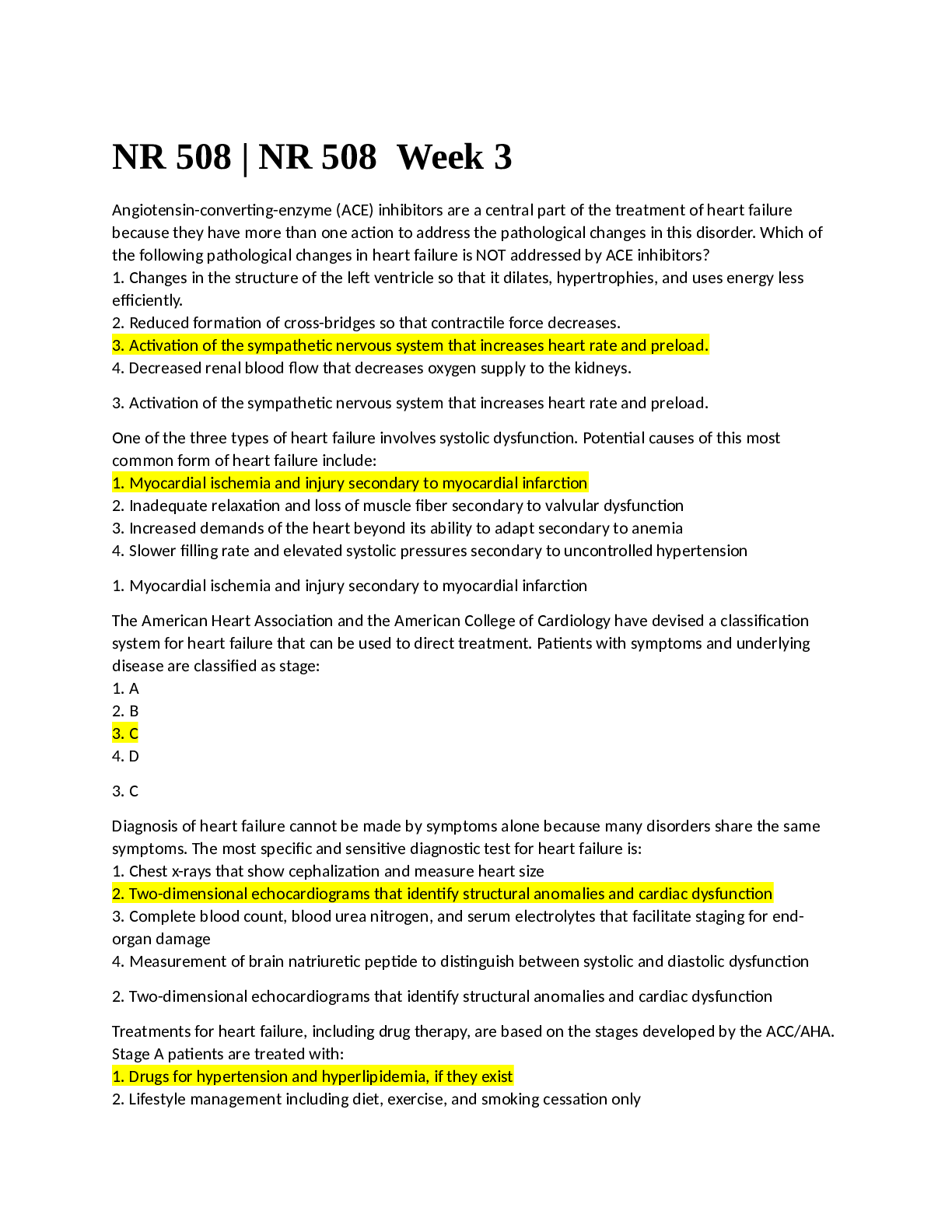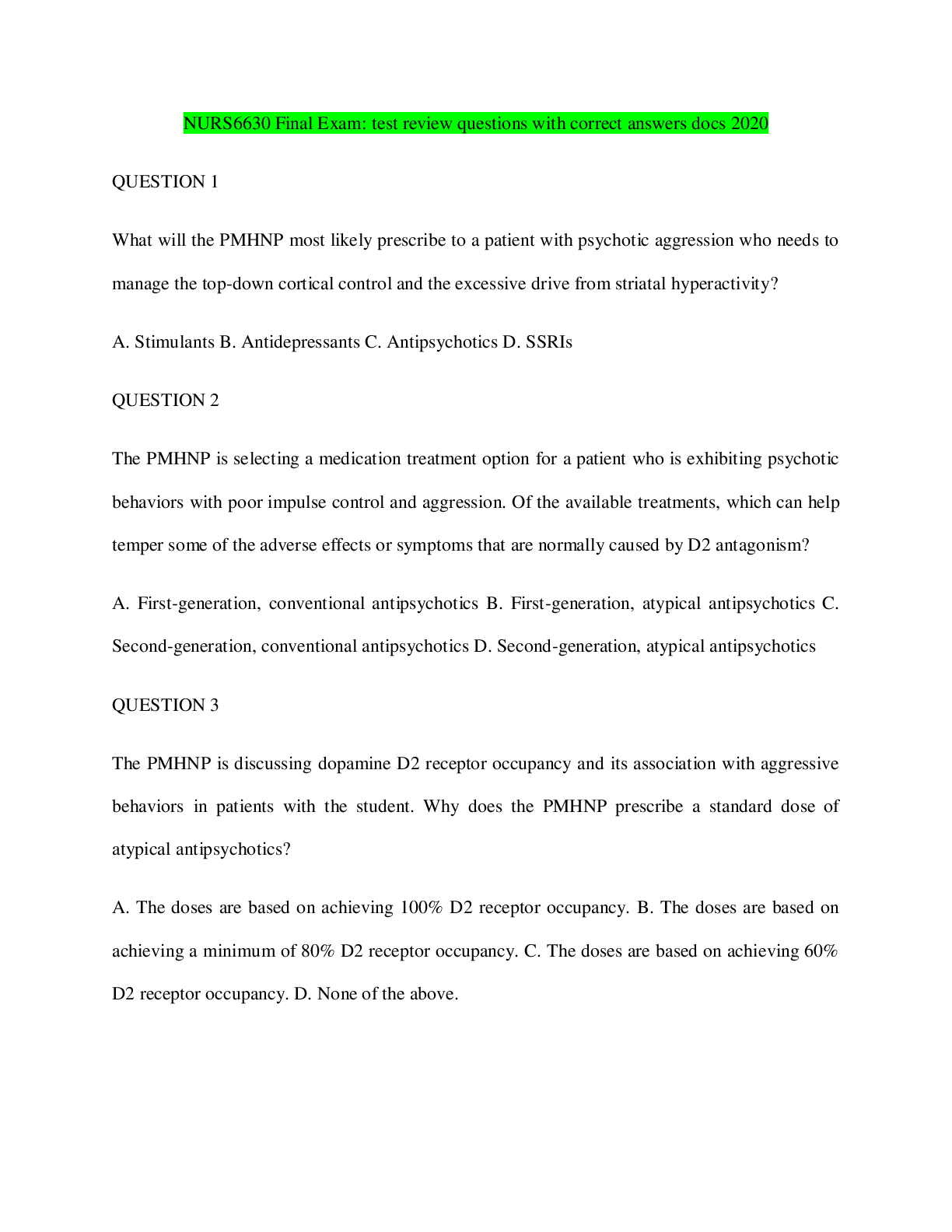Anatomy and Physiology - A&P 1 > QUESTIONS & ANSWERS > Anatomy & Physiology Openstax Chapter 4 Review Questions With Correct Answers 2022 (All)
Anatomy & Physiology Openstax Chapter 4 Review Questions With Correct Answers 2022
Document Content and Description Below
Anatomy & Physiology Openstax Chapter 4 Review Questions With Correct Answers 2022 Which of the following is not a type of tissue? A. muscle B. nervous C. embryonic D. epithelial - Answer- C. e... mbryonic The process by which a less specialized cell matures into a more specialized cell is called _____ A. differentiation B. maturation C. modification D. specialization - Answer- A. differentiation Differentiated cells in a developing embryo derive from ______ A. endothelium, mesothelium, and epithelium B. ectoderm, mesoderm, and endoderm C. connective tissue, epithelial tissue, and muscle tissue D. epidermis, mesoderm, and endothelium - Answer- B. ectoderm, mesoderm, and endoderm Which of the following lines the body cavities exposed to the external environment? A. mesothelium B. lamina propria C. mesenteries D. mucosa - Answer- D. mucosa In observing epithelial cells under a microscope, the cells are arranged in a single layer and look tall and narrow, and the nucleus is located close to the basal side of the cell. The specimen is what type of epithelial tissue? A. columnar B. stratified C. squamous D. transitional - Answer- A. columnar Which of the following is the epithelial tissue that lines the interior of blood vessels? A. transitional B. stratified columnar C. pseudostratified ciliated columnar D. stratified squamous - Answer- B. stratified columnar The ______ exocrine gland stores its secretion until the glandular cell ruptures, whereas the ______ gland releases its apical region and reforms. A. holocrine; apocrine B. eccrine; endocrine C. apocrine; holocrine D. eccrine; apocrine - Answer- A. holocrine; apocrine Connective tissue is made of which three essential components? A. cells, ground substance, and carbohydrate fibers B. cells, ground substance, and protein fibers C. collagen, ground substance, and protein fibers D. matrix, ground substance, and fluid - Answer- B. cells, ground substance, and protein fibers Under the microscope, a tissue specimen shows cells located in spaces scattered in a transparent background. This is probably ______. A. loose connective tissue B. a tendon C. bone D. hyaline cartilage - Answer- D. hyaline cartilage Which connective tissue specialized in storage of fat? A. tendon B. adipose tissue C. reticular tissue D. dense connective tissue - Answer- B. adipose tissue Ligaments connect bones together and withstand a lot of stress. What type of connective tissue should you expect ligaments to contain? A. areolar tissue B. adipose tissue C. dense regular connective tissue D. dense irregular connective tissue - Answer- D. dense regular connective tissue In adults, new connective tissue cells originate from the _______ A. mesoderm B. mesenchyme C. ectoderm D. endoderm - Answer- B. mesenchyme In bone, the main cells are_______ a. fibroblasts b. chondrocytes c. lymphocytes d. osteocytes - Answer- d. osteocytes Striations, cylindrical cells, and multiple nuclei are observed in _______ a. skeletal muscle only b. cardiac muscle only c. smooth muscle only d. skeletal and cardiac muscles - Answer- a. skeletal muscle only The cells of muscles, myocytes, develop from ________. a. myoblasts b. endoderm c. fibrocytes d. chondrocytes - Answer- a. myoblasts Skeletal muscle is composed of very hard working cells. Which organelles do you expect to find in abundance in skeletal muscle cell? a. nuclei b. striations c. golgi bodies d. mitochondria - Answer- d. mitochondria The cells responsible for the transmission of the nerve impulse are _________ a. neurons b. oligodendrocytes c. astrocytes d. microglia - Answer- a. neurons The nerve impulse travels done a(n) ________, away from the cell body a. dendrite b. axon c. microglia d. collagen fiber - Answer- b. axon Which of the following central nervous system cells regulate ions, regulate the uptake and/or breakdown of some neurotransmitters, and contribute to the formation of the blood-brain barrier? a. microglia b. neuroglia c. oligodendrocytes d. astrocytes - Answer- d. astrocytes Which of the following processes is not a cardinal sign of inflammation? a. redness b. heat c. fever d. swelling - Answer- c. fever When a mast cell reacts to an irritation, which of the following chemicals does it release? a. collagen b. histamine c. hyalurnic acid d. meylin - Answer- b. histamine Atrophy refers to _______ a. loss of elasticity b. loss of mass c. loss of rigidity d. loss of permeability - Answer- b. loss of mass Individuals can slow the rate of aging by modifying all of these lifestyle aspects except for _______ a. diet b. exercise c. genetic factors d. stress - Answer- c. genetic factors What are 5 ways to distinguish epithelial tissue? - Answer- 1. Have one free surface (apical) 2. Bound by specialized junctions 3. Attached to basement membrane 4. Avascular 5. Can easily divide and regenerate How do you name epithelial tissue? - Answer- By the number of layers and cell shape ex: simple or stratified squamous, cuboidal, columnar What are the the 8 types of epithelial tissue? - Answer- simple squamous simple cuboidal simple columnar pseudostratified columnar stratified squamous stratified cuboidal stratified columnar transitional What type of tissue forms connective tissue? - Answer- mesenchyme What are the 11 different types of connective tissue? - Answer- proper: loose, areolar proper: loose, adipose proper: loose, reticular proper: dense regular proper: dense, elastic proper: dense, irregular hyaline cartilage elastic cartilage fibrocartilage bones blood Which types of connective tissue are poorly vascularized? - Answer- cartilage, tendon, and ligaments What are the three characteristics of connective tissue? - Answer- 1. vascularized 2. composed of many types of cells 3. matrix between cells What are the two components of the matrix? - Answer- ground substance and fibers What are the fibers in the matrix? - Answer- collagen, yellow elastic, reticular Where do tissue cells in cartilage and bone reside? - Answer- lacunae What are the most common cells in connective tissue? - Answer- fibroblasts What are the two cell populations in nervous tissue? - Answer- neuroglia - protect, support, insulate neurons neurons - receive stimuli and generate electrical signals cell body dendrites axon What are the three types of muscle tissue? - Answer- skeletal, cardiac, and smooth How do you describe skeletal muscle? - Answer- voluntary control, long, cylindrical, nonbranching, and multinucleate, obvious striations How do you describe cardiac muscle? - Answer- striations, branching uninucleate cells that have junctions called intercalated discs, involuntary conrtol How do you describe smooth muscle? - Answer- found in hollow organs, two layers, contraction can constrict or dilate the lumen (cavity) and propel substances. no striations, uninucleate, spindle shape, involuntary control What are the 4 types of body membranes? - Answer- cutaneous, mucous, serous, synovial How do you define tissue? - Answer- Groups of cells that are similar in structure and function What are the three germ layers? - Answer- ectoderm, mesoderm, endoderm Describe the endoderm tissue - Answer- lung cell, thyroid cell, pancreatic cell Describe the mesoderm tissue - Answer- cardiac muscle, skeletal muscle, smooth muscle, tubule cell of kidney, RBC Describe the ectoderm tissue - Answer- skin cells, neurons, pigment cells What are the two broad categories of tissue membranes? - Answer- connective tissue epithelial membranes Name the epithelial membranes - Answer- cutaneous mucous serous Name the connective tissue membranes - Answer- synovial What are the locations of mucous membranes? - Answer- digestive, respiratory, urinary, and reproductive tracts What are the layers of mucous membranes? - Answer- surface epithelium, loose connective tissue (lamina propria) What are the layers of serous membranes? - Answer- mesothelium (simple squamous), areolar connective tissue What are the three serous membranes? - Answer- pleural (lungs) peritoneum (abdomen) pericardium (heart) *double membrane* What are the layers of cutaneous membrane? - Answer- keratinzed stratified squamous epithelium, areolar and dense irregular connective What are the layers of synovial membranes? - Answer- (no epithelium) areolar connective tissue with collagen, proteoglycans, and glycoproteins in matrix synovial fluid around joints reduces hyaline cartilage friction What are the 5 types of cell junctions? - Answer- tight, adherens, desmosomes, hemidesmosomes, and gap What are the non-anchoring junctions? - Answer- tight (stomach, intestine, bladder) gap What are the anchoring junctions? - Answer- desmosomes (attaches to cytoskeleton) hemidesmosomes (don't link adjacent cells) adherens junctions (actin filament) What are the 4 functions of epithelial tissue? [Show More]
Last updated: 1 year ago
Preview 1 out of 9 pages
Instant download
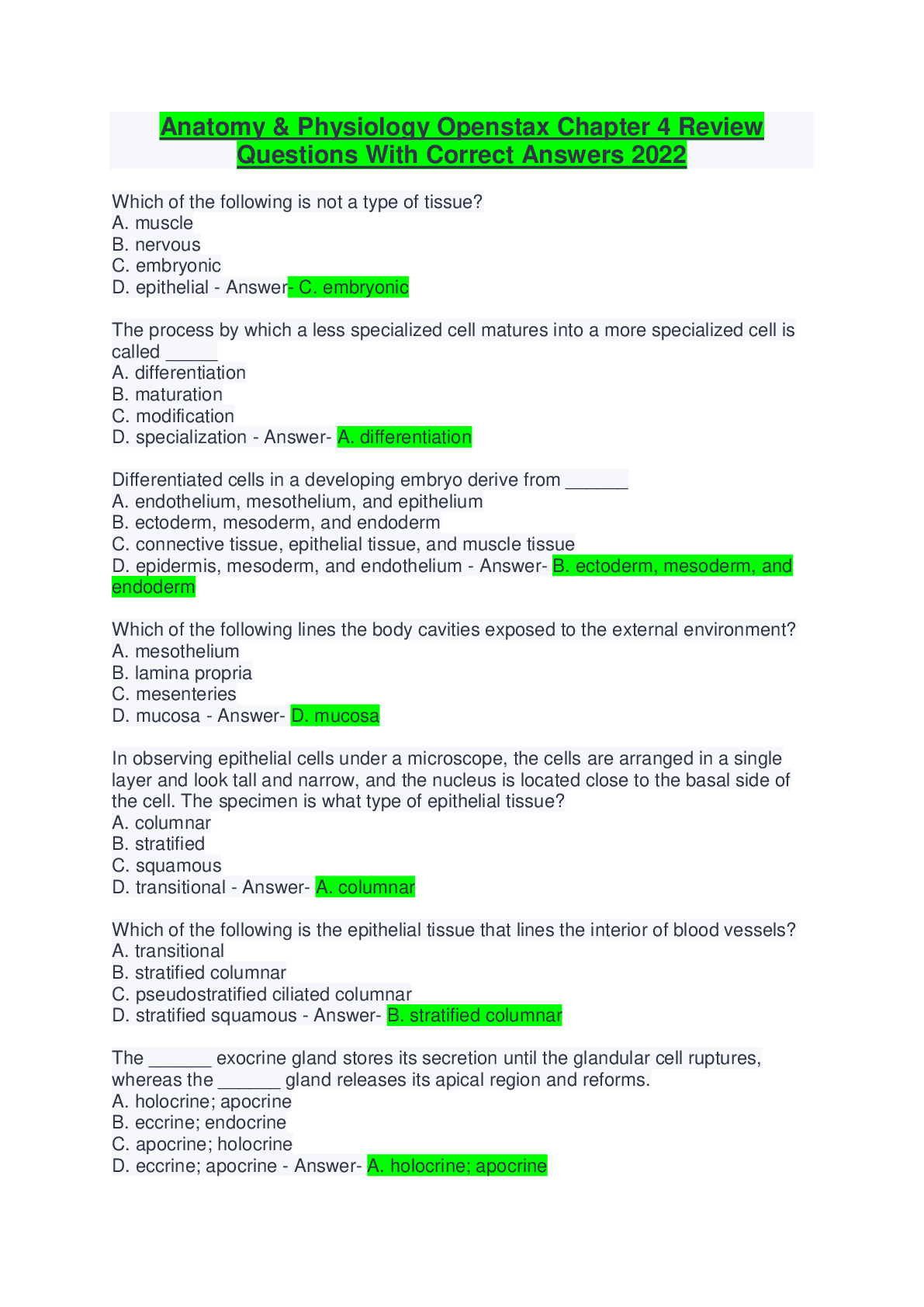
Buy this document to get the full access instantly
Instant Download Access after purchase
Add to cartInstant download
Reviews( 0 )
Document information
Connected school, study & course
About the document
Uploaded On
Sep 11, 2022
Number of pages
9
Written in
Additional information
This document has been written for:
Uploaded
Sep 11, 2022
Downloads
0
Views
105




